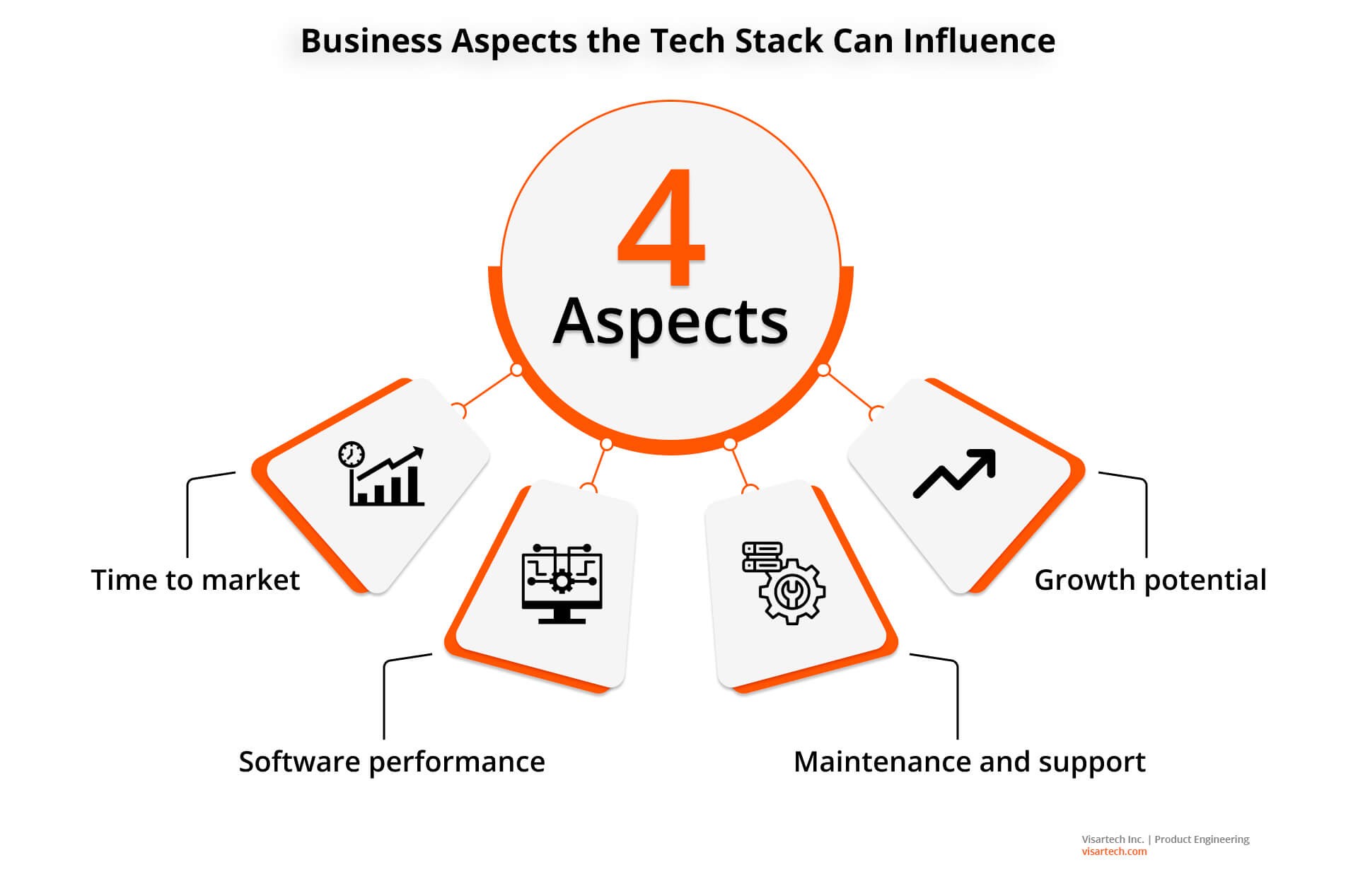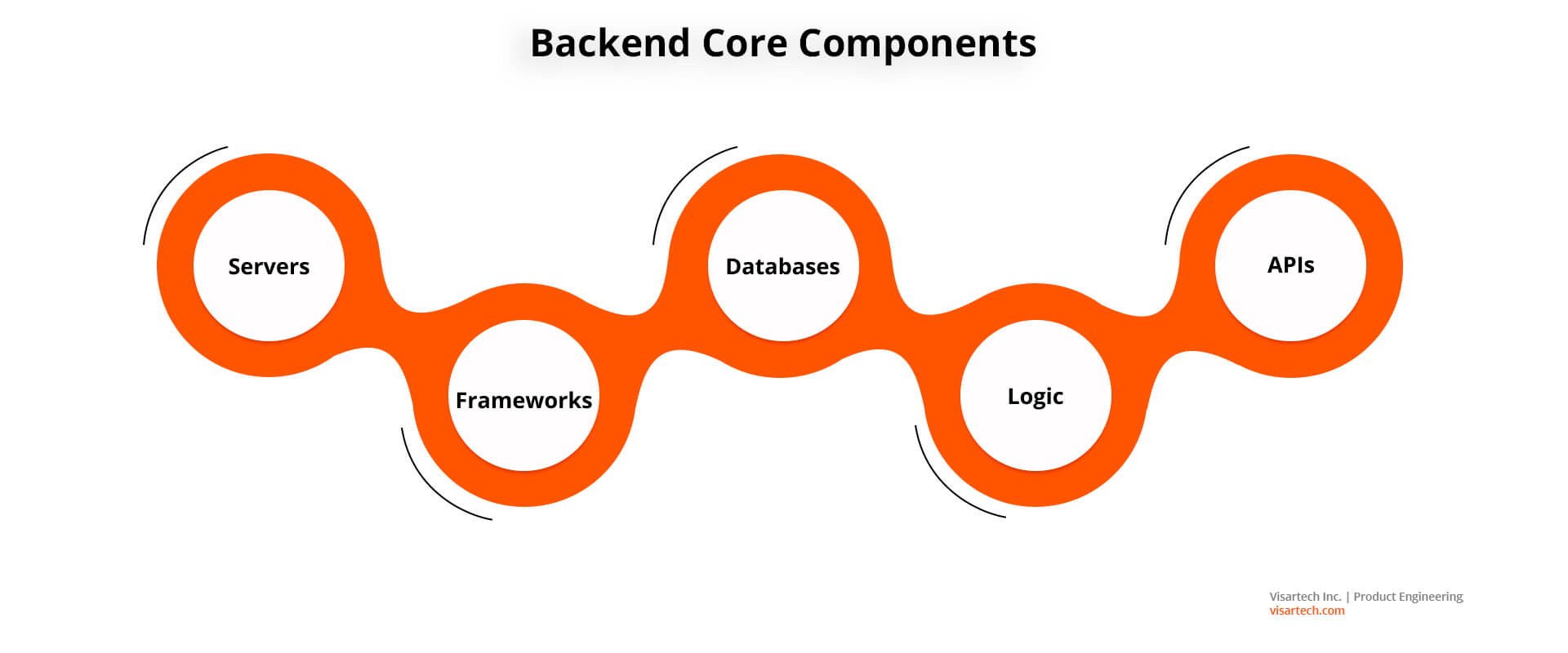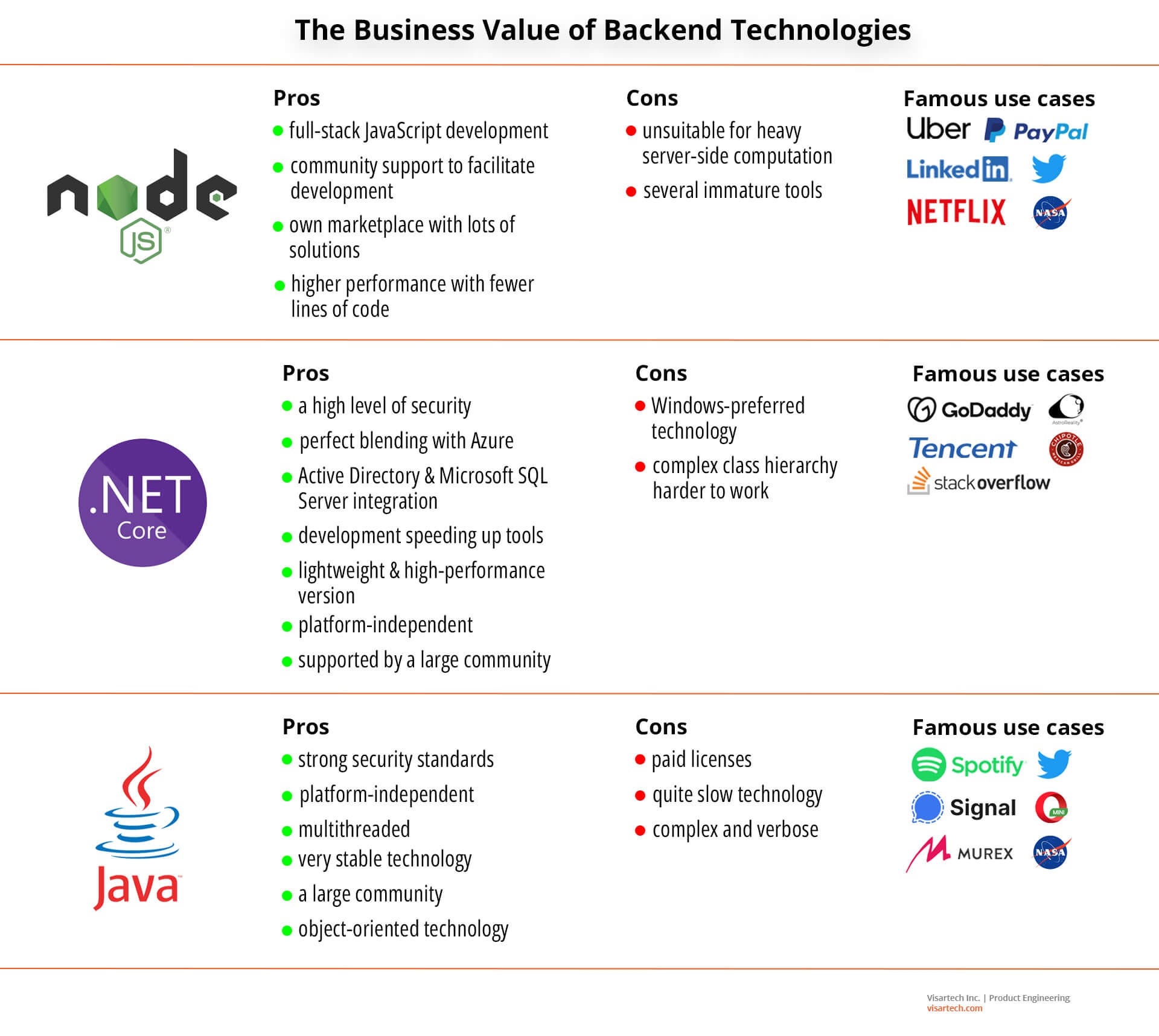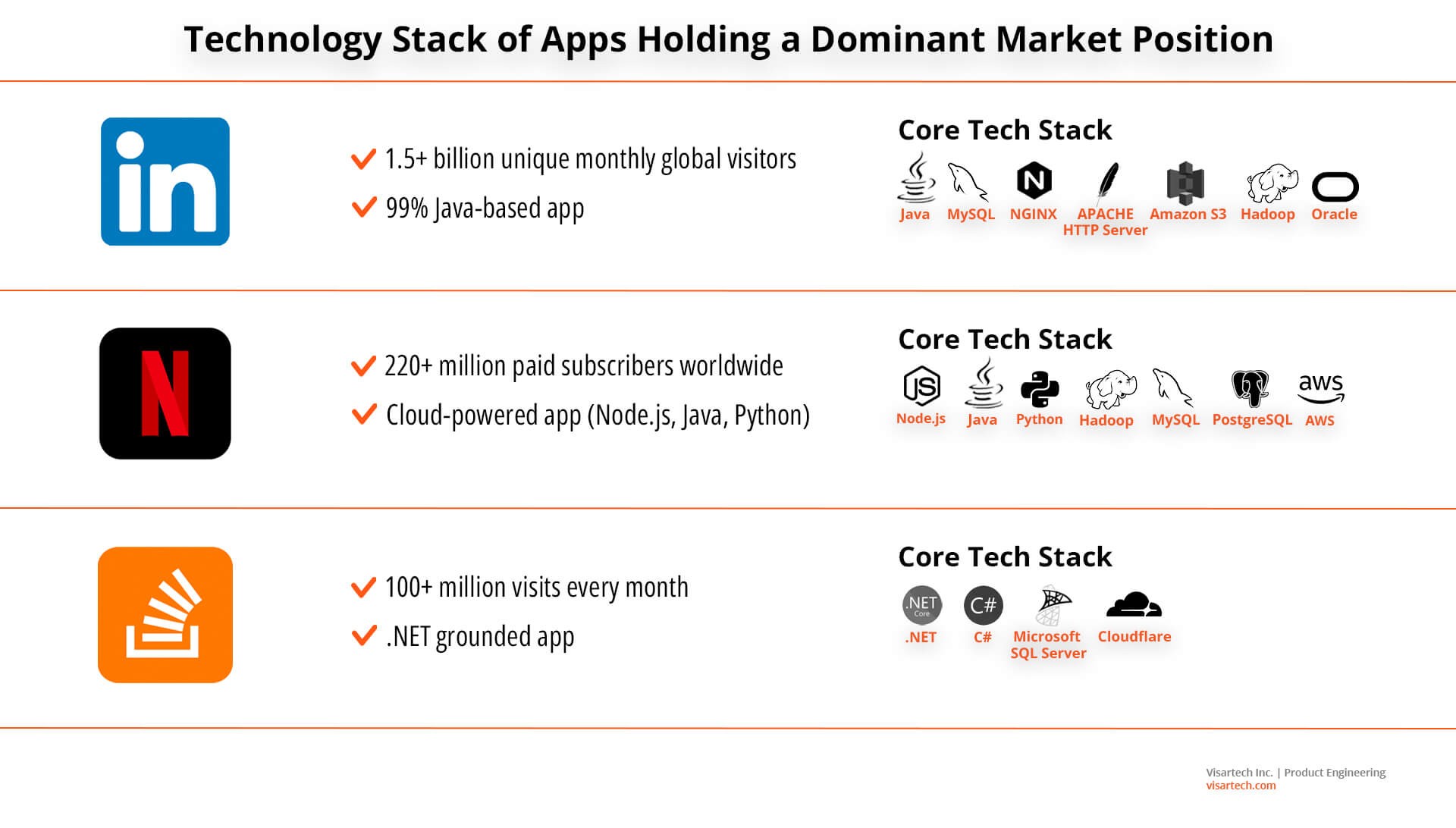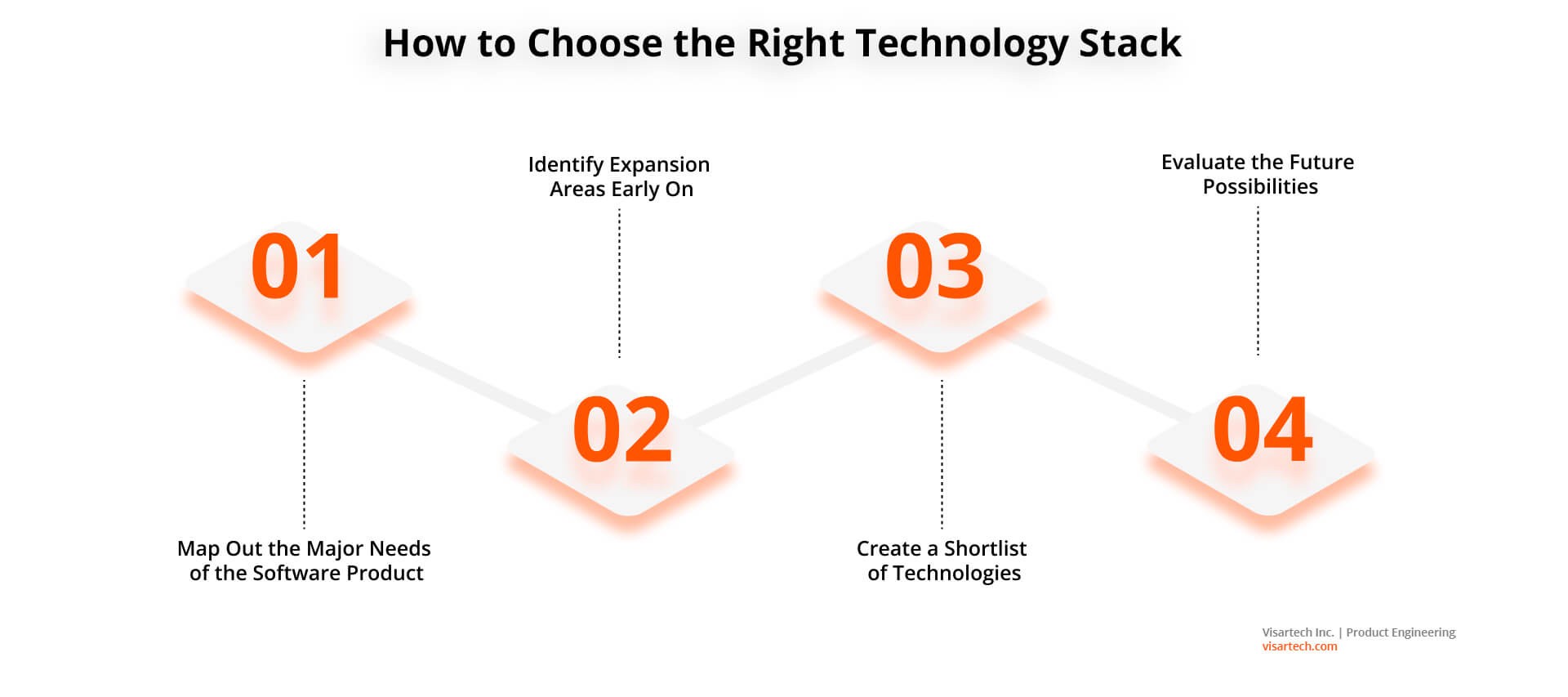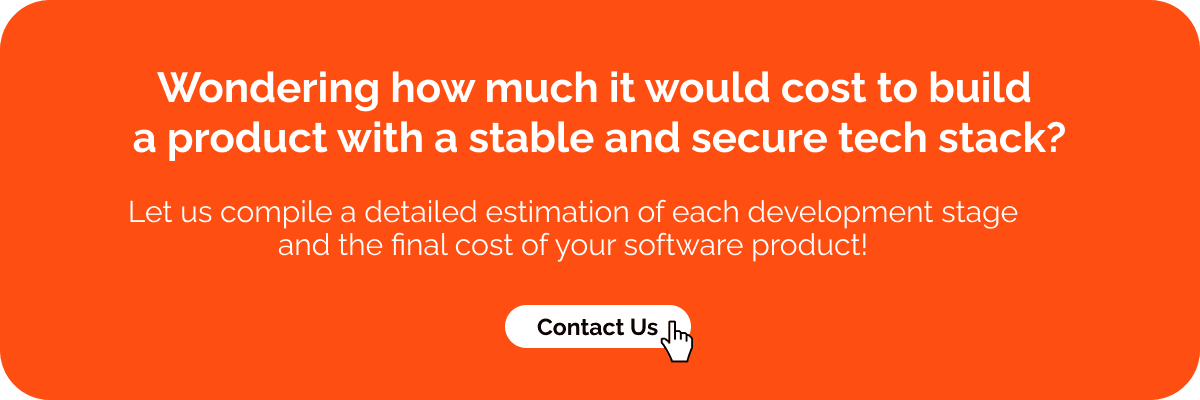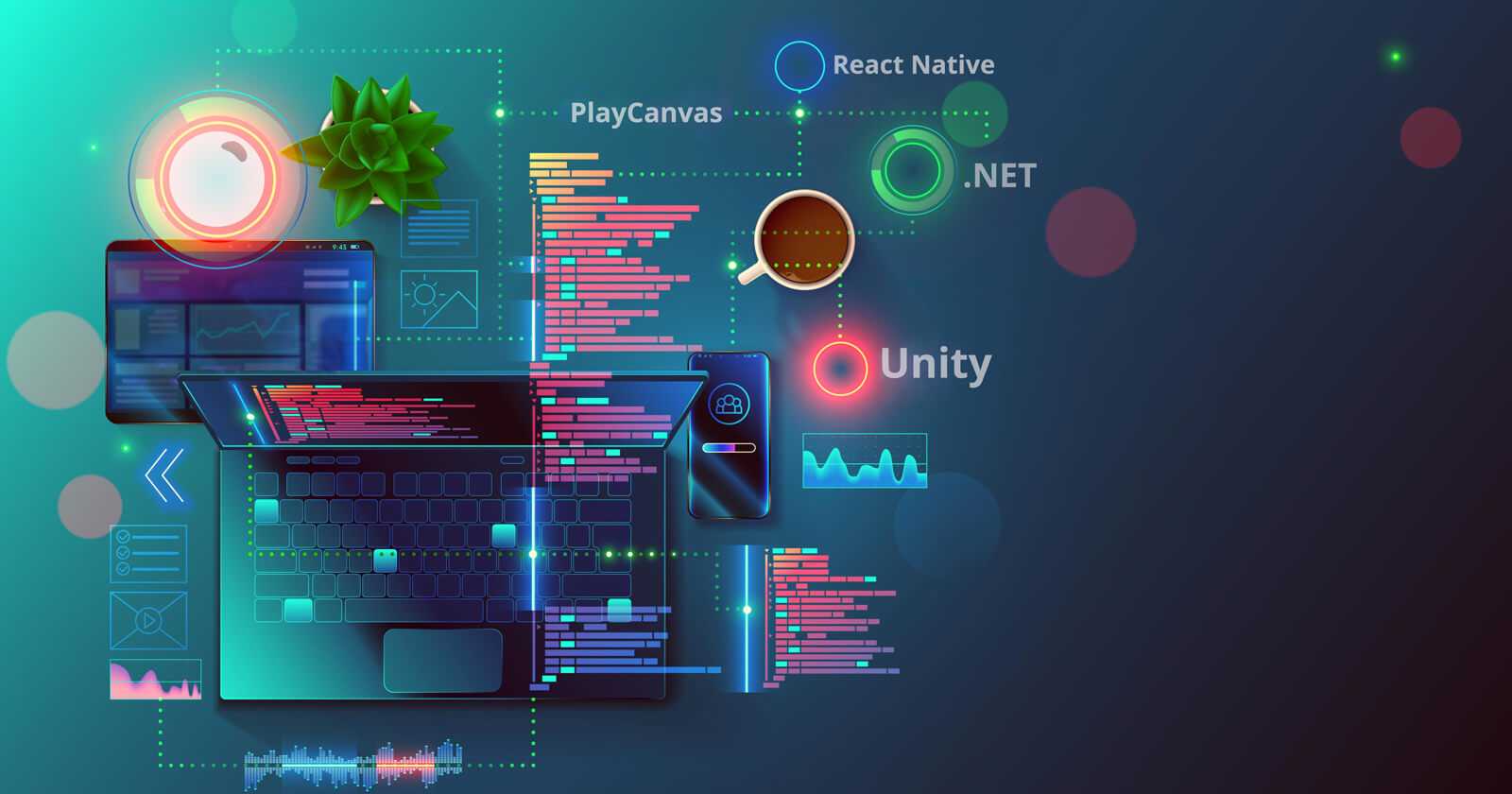Every successful software product has a well-thought technology stack under the hood. The combination of frontend and backend technologies that make the software can have a tremendous impact on many business aspects. From the availability of human resources to time to market, marketing strategy, and growth plan.
Therefore, defining the tech stack should be one of the primary tasks on the to-do list during the initial stages of software development. This comprehensive guide will help you understand:
- The essence and value of a technology stack;
- The core of the backend and its role in the success of a business;
- How to choose the right tech stack;
- The benefits of working with a technology partner and how you can find yours.
Let’s dive in!
Technology Stack: What Is It and Why Should You Care?
A tech stack is a set of technologies and tools like languages, frameworks, libraries, APIs, and more, that programmers use to build a software product. Every solution has a client and server side but we’ll talk about it in a second.
Choosing the stack is one of the big decisions that should be made early on.
The tech core of the software not only impacts further decision-making but can also affect such aspects of the business as:
- Time to market. Different technologies have different popularity. The availability of skilled programmers, the learning curve, and the robustness of the tools can greatly affect the time it will take to deliver a solution.
- Software performance. There’s a strong link between business requirements and what the technology can handle. Every technology has its intricacies and areas where it shines.
- Maintenance and support. The tech ecosystem will influence how easy it is to upgrade and customize software. Especially if you decide to pivot from your original idea.
- Growth potential. The possibilities of the technology you choose can have a significant impact on how easy it is to add new features to the software, increase user load, and so on.
Given its importance, the tech stack should be a part of business strategy. Not only for the above-mentioned reasons but also because changing the stack is a tough task. Switching stacks involves rewriting large chunks or all of the source code to meet new business needs. This not only takes a lot of time but can also cost a fortune.
The Basics: Front-end vs Back-end
Every software product has a back end and a front end. You might know them as the server- and client-side respectively. Imagine a grocery shop. When you walk into the store you see shelves with beautifully packaged products. The shop has different departments and a layout which helps you find the necessary products. The owners have also taken care of the interior design to provide a pleasant shopping experience. This is the client side.
There’s also the back of the store that can be accessed by authorized personnel only. It serves as storage and ensures the seamless functioning of the store. This is the back end.
Back to software development. Simply put, the client side provides an interface that allows users to interact with the software. The server side runs behind the scenes and does all the heavy lifting. The front end is all about a smooth user experience, while the back end makes interaction possible by responding to incoming client requests. Neither can exist independently and both components continuously “talk to each other” via HTTP requests.
The Core Of The Backend
Before we get into the components of backend architecture, let’s see why the back end is arguably more important than the front end. Without a doubt, the client-side plays a vital role in the overall success of the software solution.
However, it’s the backend that stores all the valuable data and enforces business and application logic. Having a beautifully designed product cannot compensate for low performance. Other than that, sensible backend architecture and development stack allow the creation of complex ecosystems and exquisite software solutions.
At Visartech, we believe that to ensure the smooth operation of the enterprise, it is necessary to build a robust backend as well as maintain a stable IT infrastructure. So much so that you can see the “IT Infrastructure First” statement on the front page of our site.
Read also: Everything You Need to Know About Visartech Tech Stack
Find out our approach to building high-quality, cutting-edge software
Not that we know the importance of the server side, let’s learn what components it’s made of.
- Servers
A server is a computer system that’s responsible for accessibility. For example, whenever a customer goes on a website, their computers send a request to the server to load the website. So, the primary task of the server is to listen and respond to incoming requests.
Depending on the size and requirements, organizations can set up dedicated servers to provide services. For example, database servers, web servers, mail servers, etc. This is the case for larger businesses. Smaller organizations can set up a single server that’s going to handle all types of requests.
Servers must be up and running 24/7. If a server goes down then no end users will be able to use your product. Downtime is one of the costliest events an organization can face. Let’s take Facebook as an example where a 14-hour downtime cost the company $90 million in revenue.
- Frameworks
Think of a framework as an off-the-shelf skeleton of a software application. All software has certain functionality that is standard. Back in the day, programmers started with a clean slate when they had to write code. Writing the same code over and over to implement that standard functionality resulted in libraries that then evolved into frameworks.
Simply put, frameworks are bits of reusable code that provide specific functionality. They offer a standardized way of building software solutions while saving a great amount of time. Frameworks serve as a guide to structure code, logic, and other aspects of the backend architecture.
- Databases
Data is the heart and soul of the business. It comes from many sources in many forms and shapes. Customers share their personal information when they place an order, and businesses have data they use to provide their services and sell goods.
Databases are used to efficiently store, organize and manage large volumes of data. These days, there are two most commonly used database models: relational and non-relational. Relational databases use a collection of tables that are related to each other. Non-relational databases can store different types of data, which are not interrelated.
- Logic
For the software to do its job correctly, it must follow certain rules. In the development of a backend app, the logic describes the sequence of operations that must be performed to complete a given task.
It’s also a way that the entities are modeled and the rules applied to those entities that all together reflect the business requirements. In backend architecture, logic is created to run almost exclusively on servers, interpreting inputs and producing outputs.
- APIs
Application Programming Interface (API) is a bridge between the client and server sides. The way it works is that the client side sends a request to the server, which first gets validated by the API. If the request is valid, the API then transfers it to the server. The latter creates and sends a response, which again gets validated by the API, and is then transferred to the client.
Other than that, the API is also used to integrate third-party applications and services. This allows adding features to the software without having to write your code. For example, using the API from popular payment processors like Stripe, you can add the payment feature to your product. It’s faster and easier because you don’t have to deal with payment processing, card data storage, etc.
The Business Value of Backend Technologies
There’s a myriad of backend technologies available out there. From a technical point of view, they all have specific use cases as different technologies can tackle different tasks. However, the back-end architecture also contains business logic. This means that each technology also has a business use.
In this section, we will be looking at some of the most commonly used backend technologies from a practical, business point of view.
Node.js
JavaScript is the most popular front-end technology used in 95% of web projects. But you can’t use bare JavaScript for server-side rendering, and that’s where Node.js comes into play. It’s a server-side runtime environment that allows using JavaScript across the entire stack. Node.js extends the power of JavaScript to the server side.
Using one language across the stack allows you to deliver the software product faster, lower the development cost, and simplify the scaling process. However, there are several other things about Node.js that differ from other backend development technologies. First are the non-blocking I/O and asynchronous concepts. The second is that Node.js uses a single thread.
The non-blocking nature of the Node.js backend makes it perfect for applications that read and write a lot of data, a.k.a. I/O intensive. In practice a single thread handles requests. Let’s say that a request that has arrived needs to query a database. The thread will handle that request and put it in the event queue, which is monitored in the background. Without waiting for a response, Node.js will use the same thread to service the next request while monitoring the event queue to respond to the first request.
Unlike synchronous multi-threaded architectures, with Node.js you don’t need to add more hardware to handle more requests.
Where Node.js shines: streaming apps, real-time applications, microservices architecture, web servers, and single-page applications.
Pros of Node.js:
- Using JavaScript across the entire stack makes it easier to sync the client and server sides and helps speed up the development process.
- Node.js has its independent foundation which was organized in 2015 by IBM, PayPal, Microsoft, SAP, and Fidelity. It includes a large community that facilitates the advancement of the core tools.
- Node.js has its marketplace called NPM which offers a myriad of ready-made solutions for server-side rendering.
- Having inherited much of the JavaScript programming, using Node.js for the backend allows reaching high performance with fewer lines of code.
Cons of Node.js:
- Not suitable for heavy server-side computation. CPU-intensive operations diminish all the advantages of Node.js and decrease performance. Some examples of CPU-intensive software products are video games or heavy video and image processing apps (think YouTube and Photoshop).
- Immature tools. Yes, there is a wealth of tools to choose from, and the core tools are stable and reliable. Some tools are poorly documented and not well-tested.
Famous use cases: Uber, PayPal, LinkedIn, Netflix, Twitter, and NASA.
.NET
In 2002 Microsoft came up with the idea of the .NET platform that was initially purposed to build Windows apps only. Due to the rapid advancement of technologies, the platform quickly became outdated. Therefore, in 2016 Microsoft released .NET Core. The new iteration had been completely rewritten to enable cross-platform development. Finally, in 2021 Microsoft released .NET 6 which unified all tools under the hood of .NET into one backend technology.
.NET is loved for many reasons. To start, the platform is considered to be one of the best for building dynamic, robust web solutions. It provides a dedicated framework for web development along with seamless integration with Microsoft Azure.
The technology is also very mature and versatile. Developers can choose from multiple languages to build .NET software products. There’s also a large number of libraries and other tools available. Altogether, these facilitate flexibility and faster delivery of the end solution.
Another thing that adds to the strengths of .NET is security. The platform is maintained by Microsoft and gets regular updates including security patches.
Given its platform independence, reliability, and high performance, .NET is considered an enterprise-level technology. Besides, .NET software products are considered easy to scale. With .NET there’s no need to reinvest in building a new application or change a tech stack as the business grows.
Where .NET shines: web and desktop applications, IoT, microservices, gaming, machine learning, and large-scale enterprise applications.
Pros of .NET:
- The platform offers plenty of ways that allow delivering a high level of security. Microsoft also releases regular security updates;
- .NET blends perfectly with Azure allowing to build a cloud-based infrastructure;
- integration with Active Directory and Microsoft SQL Server;
- It’s a mature platform that supports multiple languages, and provides a wide range of methods and other tools that speed up the development;
- The latest versions of .NET Core are lightweight and high-performance;
- It’s platform-independent;
- .NET provides robust debugging tools which help improve the quality of the end solution;
- Other than Microsoft, .NET is also supported by a large community of .NET Foundation.
Cons of .NET:
- Though you can build software using any operating system, .NET is Windows-preferred technology;
- The complex class hierarchy makes it harder to work with .NET;
Famous use cases: GoDaddy, StackOverflow, Tencent, Chipotle, AstroReality
Java
Java is a backend technology that over 25 years of its existence grew to power 97% of enterprise desktop software. Sure, Java can be used for small applications too, but enterprise software development is where it shines.
Java backend technologies are seen to be one of the most stable, and enterprise-level applications have to be stable. There’s a variety of well-tested libraries and frameworks, as well as a large community.
Other than that, Java is a robust technology with a vast variety of libraries, frameworks, and other tools. There are several ways this is beneficial to enterprises. First is that they get all the freedom of choice to solve very specific challenges. The second is that the abundance of tools allows enterprises to enforce their usually strict corporate standards.
Last but not least, the Java backend is platform-independent. It’s famous for “ Write once, run anywhere” or WOMO. What this means is that developers can build a product for Windows, compile it to bytecode, and run it on other OS that supports a Java Virtual Machine (JVM).
Where Java shines: big data, Internet of Things (IoT), finance apps and fintech, healthcare, and social media apps.
Pros of Java:
- Allows enforcing strong security standards.
- Platform-independent: write the code once and run it on other operating systems.
- Multithreaded, thus, allows handling multiple requests simultaneously.
- Java is a very stable technology thanks to regular updates.
- There’s a large community around Java which adds to the stability of this technology.
- Java is an object-oriented technology which means that you can split the code into smaller bits for easy management and testing.
Cons of Java:
- Oracle introduced paid licenses for Java Standard Edition 8 and later for business and commercial use.
- Java is often criticized for being slow. Part of the reason is that the JVM runtime needs to convert the code into machine language.
- Java backend code can quickly become complex and verbose, making it difficult to read and work with.
Famous use cases: Spotify, Twitter, Signal, OperaMini, Murex, NASA WorldWind.
Breaking Down the Tech Stack Behind Industry-Leading Apps
To get valuable insights into backend architecture development, it makes sense to look at the existing projects of other companies. So that you make your solution the same success.
Let’s consider in detail the most prominent characteristics of the backend architecture behind market-leading apps.
LinkedIn Tech Stack
LinkedIn is the world’s biggest and best-known professional network with roughly 1.5 billion unique monthly global visitors. We already know that Java is considered a great technology for social networking apps.
LinkedIn is an excellent example of a Java-based web application. Indeed, there are other technologies in the mix. However, 99% of LinkedIn services are written in Java.
Firstly, the company keeps a strong focus on privacy and Java allows sticking with that. Secondly, LinkedIn loves Java for the fact that it’s a statically typed technology. This offers many advantages but the main being confidence in adding new services. Using Java allows LinkedIn to catch any trivial bugs before the release and therefore deliver better quality services.
Generally, the core technologies of LinkedIn include Java, MySQL, NGINX, Apache HTTP Server, Amazon S3, Hadoop, and Oracle.
Netflix Tech Stack
Netflix has risen to a much higher level of success since it was just a DVD-rental store. Currently, it’s a streaming entertainment giant that offers its services to more than 247.2 million paid subscribers all over the world. The success of Netflix heavily relies on the company’s ability to foresee trends and pinpoint customers’ wishes. Yet, Netflix also has a knack for using technologies to give customers what they want on any device and scale their solution.
Back in the day, Netflix used Java and JavaScript for the server and client-side rendering of their website respectfully. This combination harmed the service startup time. Users had to wait for some time to start browsing resulted.
Netflix has taken on a challenge to improve its performance and eventually managed to reduce the startup time by 70%. Since 2013 the company has been using Node.js for its web backend which brings faster processing time to the server and ultimately better customer experience.
Overall, Netflix uses different technologies to keep their product up-to-date. However, the main ones consist of Node.js, Java, Python, Hadoop, MySQL, PostgreSQL, and Amazon AWS.
StackOverflow Tech Stack
StackOverflow is best known in the software industry. It’s a QA site for software developers which receives 100+ million visits every month.
From the beginning, the company had been using the .NET technology to build its applications. However, with the release of the .NET Core, they’ve decided to make a big move and switch the whole infrastructure to the latter. Here’s what they achieved.
First things first, the company was able to improve the performance of its apps, and thus, deliver the information to its users faster. Switching to .NET Core allowed for an easier development process. The team can build an application and run it on different devices across the team.
Finally, StackOverflow prioritizes using the cloud for ease of deployment and hosting. Their stack allows them to host the StackOverflow app in the cloud using Azure and make upgrades much faster.
The core technologies of StackOverflow include .NET, C#, Microsoft SQL Server, and Cloudflare.
Tips on How to Choose Technology Stack
There’s no silver bullet for deciding on a technology stack for the development of the backend app. The notion that there’s the best technology or the best stack is misleading and gets a lot of people stuck. The truth is that what works for one business might not work for another. Even two very similar projects will be different in size, and complexity and will surely have individual business objectives.
Therefore, when deciding on the backend technologies, the top three things you should consider are the size, complexity, and objectives of your project. Let’s dive a little deeper.
Map Out the Major Needs of the Software Product
Your future product has to be able to do certain things, and that already limits the number of technologies you can choose from. To help you with this task, we recommend making a detailed tech specification. First, write down all major requirements like supported platforms, important features, and integrations. Once you have that, you can get more granular and outline nice-to-have features.
Having a distinct list of features and functionalities will help you stay on track and make sure that all essentials are covered.
Identify Expansion Areas Early On
Let’s say you’re building a desktop application. There’s always a chance that soon you will also want to complement it with a web version. If you plan on quick growth then choose your tech stack strategically. Planning for certain changes will make their implementation faster and easier.
However, keeping a balance here is critical. No one wants to get caught up in what might be and overengineer the product from the get-go. Take a close look at your project and try to identify areas that have expansion potential, and build your backend architecture and logic based on that.
Create a Shortlist of Technologies
Now that you have your tech specification or a list of must-have features, you can make a technology list and stack the two. For example, you’re looking at frameworks for your software product. Make a list of frameworks you could potentially use and see how well they fit your requirements.
Evaluate the Future Possibilities
Maturity and community/support are two important aspects to consider when choosing your technology stack. The more mature a technology is the more stable, reliable, and robust it usually is. And the larger the community the easier and faster the support a backend developer can get.
So, here you want to look at two things. First, evaluate what’s already been done for the technology of your choice. For example, check how often new versions are released and what those releases are about. Let’s take .NET. If you look at the upgrades Microsoft has done over the years, you’ll see that performance speed is one of the major improvements.
The key takeaway: look at how the technology has changed throughout its existence and research the direction it’s going to see whether it’s worth the investment.
How to Choose a Reliable Technology Partner
We all know the saying: “If you want a thing done well, do it yourself.” But in the business world, this approach just doesn’t scale. First of all, doing everything yourself is physically impossible. Second of all, as a business owner, you already have a lot on your plate. And finally, to build a software solution, you would need to be a brainiac to do the job that usually takes a team.
A smarter thing to do would be to hire a tech agency. As a matter of a fact, the greatest power of the leader is delegation. With the right technology partner, you can get access to knowledge and other resources that can help you build better solutions and achieve greater goals.
On a side note, we recommend opting for a full-cycle agency, like Visartech. We walk you through each stage of software development until the day of release, and beyond. On top of that, our team also takes a proactive approach to scaling your software along the way.
Gauge the Communication Style
Without good communication skills, the agency won’t be able to turn your tech specification into software. Therefore, figuring out whether they can communicate in a clear and timely manner is a primary task.
Read also: 10 Reasons to Write a Technical Specification
Learn what it is and how it facilitates software development
Try to evaluate if the partner is genuinely interested in helping you build a business, or if they’re just in it for the money. Take note if they’re asking additional questions aimed to gain a deeper understanding of your goals and objectives.
Differentiate Knowledge from Expertise
There’s a distinct difference between a knowledgeable person and an expert. It lies in the ability to guide, make relevant suggestions, and, most importantly, open new perspectives.
So, when the initial stage is passed and you feel like you have a good connection, pay attention to the partner’s way of thinking. Do they just go with the flow or do they seek disruptive solutions? Can they explain why a certain technology is better for your case than the other?
Seek Value, Not Price
Sure, you operate a certain budget that you can allocate to software development. But instead of looking for the cheapest option, look for a cost-effective one. The last thing you want to do is invest your time and money into building a software product and having to pay twice for someone to re-do the whole thing.
Wrapping Up
Choosing the backend technologies to use for your future software solution is not an easy task. At Visartech, we acknowledge the fact that every project requires an individual approach. Therefore, we help pick the best tech tools based on the unique requirements and needs of the business.
Contact our team to discuss your tech stack and let’s start building your software solution!

